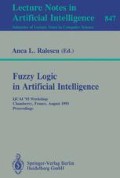Abstract
Functionality-based object recognition systems recognize objects at the basic category level by reasoning about how well they support the expected function. Such systems naturally associate a “measure of goodness” or “membership value” with a recognized object. This measure of goodness is the result of accumulating measures from potentially many primitive evaluations of different properties of the object's shape. Previously the measure function for each of the primitive evaluations has been handcrafted by the designer of the recognition system. A method is presented here for automatically learning the primitive evaluation measure functions given a set of example objects labeled with their desired overall measure. The learning algorithm described here should be generally applicable to any problem in which low-level “fuzzy” membership values are combined through an and tree control structure to give a final overall measure.
This research was supported by Air Force Office of Scientific Research grant F49620-92-J-0223 and National Science Foundation grant IRI-91-20895.
Preview
Unable to display preview. Download preview PDF.
References
L. Bogoni and Bajcsy. “An Active Approach to Characterization and Recognition of Functionality and Functional Properties”. In AAAI-93 Workshop on Reasoning about Function, pages 201–202, Washington, D.C., July 1993.
P. P. Bonissone and K. S. Decker. “Selecting Uncertainty Calculi and Granularity: An Experiment in Trading-off Precision and Complexity”. In L. Kanal and J. Lemmer, editors, Uncertainty in Artificial Intelligence, pages 217–247. North-Holland Publishing Company, 1986.
M. Brand. “Vision Systems that See in Terms of Function”. In AAAI-93 Workshop on Reasoning about Function, pages 17–22, Washington, D.C., July 1993.
M. Di Manzo, E. Trucco, F. Giunchiglia, and F. Ricci. “FUR: Understanding Functional Reasoning”. International Journal of Intelligent Systems, 4:431–457, 1989.
K. Kise, H, Hattori, and T. K. K. Fukunaga. “Representing and Recognizing Simple Hand-tools Based on Their Functions”. In Asian Conference on Computer Vision, pages 656–659, Osaka, Japan, Nov. 1993.
T. M. Mitchell, R. M. Keller, and S. T. Kedar-Cabelli. “Explanation-Based Generalization: A Unifying View”. Machine Learning, 1:47–80, 1986.
E. Rivlin, A. Rosenfeld, and D. Perlis. “Recognition of Object Functionality in Goal-Directed Robotics”. In AAAI-93 Workshop on Reasoning about Function, pages 126–130, Washington, D.C., July 1993.
E. Rosch, C. B. Mervis, W. D. Gray, D. Johnson, and P. Boyes-Braem. Basic objects in natural categories. Cognitive Psychology, 8:382–439, 1976.
L. Stark and K. W. Bowyer. “Achieving generalized object recognition through reasoning about association of function to structure”. IEEE Transactions on Pattern Analysis and Machine Intelligence, 3(10):1097–1104, 1991.
L. Stark and K. W. Bowyer. “Function-based recognition for multiple object categories”. Image Understanding, 59(10):1–21, Jan. 1994.
L. Stark, L. O. Hall, and K. W. Bowyer. “An investigation of methods of combining functional evidence for 3-D object recognition”. Int. J. of Pattern Recognition and Artificial Intelligence, 7(3):573–594, June 1993.
M. Sutton, L. Stark, and K. W. Bowyer. “Function-based generic recognition for multiple object categories”. In A. K. Jain and P. J. Flynn, editors, Three-dimensional Object Recognition Systems, pages 447–470. Elsevier Science Publishers, 1993.
L. Vaina and M. Jaulent. “Object structure and action requirements: a compatibility model for functional recognition”. Int. J. of Intelligent Systems, 6:313–336, 1991.
P. H. Winston, T. O. Binford, B. Katz, and M. Lowr. “Learning physical descriptions from functional definitions, examples, and precedents”. National Conference on Artificial Intelligence, pages 433–439, 1983.
Author information
Authors and Affiliations
Editor information
Rights and permissions
Copyright information
© 1994 Springer-Verlag Berlin Heidelberg
About this paper
Cite this paper
Woods, K., Cook, D., Hall, L., Stark, L., Bowyer, K. (1994). Learning fuzzy membership functions in a function-based object recognition system. In: Ralescu, A.L. (eds) Fuzzy Logic in Artificial Intelligence. FLAI 1993. Lecture Notes in Computer Science, vol 847. Springer, Berlin, Heidelberg. https://doi.org/10.1007/3-540-58409-9_7
Download citation
DOI: https://doi.org/10.1007/3-540-58409-9_7
Published:
Publisher Name: Springer, Berlin, Heidelberg
Print ISBN: 978-3-540-58409-4
Online ISBN: 978-3-540-48780-7
eBook Packages: Springer Book Archive

